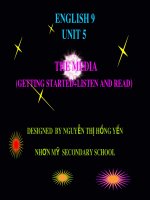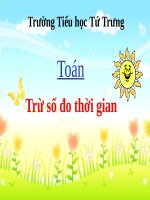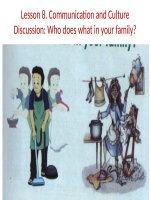slide bài giảng UNIT 5 CULTURAL IDENTITY LISTENING
Bạn đang xem bản rút gọn của tài liệu. Xem và tải ngay bản đầy đủ của tài liệu tại đây (2.67 MB, 22 trang )
WELCOME TO OUR CLASS
Look at the pictures and answer the
questions
What country do you think of when you you see these pictures?
Japan
Preserving cultural identity
What d
o you
know
about
the Ja
panes
● La
e’s cu
ngua
lture?
ge
●
N a ti o
nal f
● Tra
ower
ditio
nal c
o st u
mes,
food
…
etc
Language: Japanese
Traditional costume: Kimono
Traditional food: Shusi
Traditional game: Kendama, Takoage
Traditional flower: Cherry blossom
Vocabulary
❶ Cultural identity
Bản sắc văn hóa
❷ Traditional costumes
Trang phục truyền thống
❸ Belief
Tín ngưỡng
❹ Cultural practices
Phong tục văn hóa
❺ Maintain
Duy trì
Vocabulary
- Cultural identity /ˈkʌltʃərəl/
/aɪˈdɛntɪti/
Bản sắc văn hóa
- Traditional costume
/trə´diʃənəl/
/´kɔstju:m/
Trang phục truyền thống
- Belief
/bɪ'li:f/
: Tín ngưỡng
- Cultural practice
Phong tục văn hóa
- Maintain
: Duy trì
[mein'tein]
/ˈkʌltʃərəl/
/´prỉktis/
Task 1. Listen and read.
Mr Brown: Hello everybody. Hope you're all working on your essay on cultural identity. Do you have any questions?
Van: Yes. I'm not quite sure about how people express their cultural identity.
Mr Brown: That's an interesting question. Can anyone give some examples?
Lam: I think people can do that through the language they speak, the food they eat and ... certain styles of clothing. For example, some people still wear their traditional costumes so they
can preserve their national identity.
Mr Brown: That's right. It can also be expressed by beliefs and cultural practices.
Yumi: Do you mean people's religious beliefs, music activities and festivals?
Mr Brown: Correct. Any other questions?
Lam: I wonder... why people need to protect their cultural identity.
Yumi: You live here, in your motherland, so you can't see why this is important. But for me, a Japanese living in Viet Nam, it's essential to understand my family history and traditions.
Van: Interesting. Are your parents both Japanese, Yumi?
Yumi: Yes, but they've been living here for twenty years, and they're afraid that my sister and I are becoming less and less familiar with our traditions.
Lam: So how do you maintain your culture?
Yumi: Well, we wear kimonos on special occasions and celebrate Japanese festivals such as the cherry blossom festival. We also eat sushi, sashimi and udon noodles. At home we speak
Japanese only.
Van: Do you ofen go back home?
Yumi: I've been to Kyoto four or fve times to visit my grandparents. But to tell you the truth, I don't know whether Viet Nam or Japan is really my home. My parents are from Japan, but I
was born and grew up here.
Mr Brown: I'd be interested to read about your experiences in Viet Nam in your essay, Yumi. OK, just to remind you that the essays are due next Wednesday and late submissions won't be
accepted.
Task 2. Complete the diagram.
language
food
beliefs
clothing
Cultural practices
Language
•
e
Vietnamese
Food
Square and
round sticky cake
Pho (Phở)
Clothing
Ao dai (Áo dài)
Ao ba ba (Áo bà ba)
Belief
Ancestor worship
Cultural practices
Hung King’s Festival
Quan ho Singing
Task 4. Find the verb or adjective that goes with each of the following nouns or noun phrases. If necessary,
use a dictionary to check the meaning.
express / protect
1. ___________________________________their cultural identity
traditional
2. ___________________________________costumes
cultural
3. ___________________________________practices
understand
4. ___________________________________my
family history
maintain
5. ___________________________________your
culture
Task 5. Read the conversation again and write the correct tenses of the verbs in brackets.
1. My parents (live)_______________________for
have been
twenty
livingyears.
2. I (be) __________________________________to Tokyo four or fve times to visit my
grandparents.
have been
Thank you









